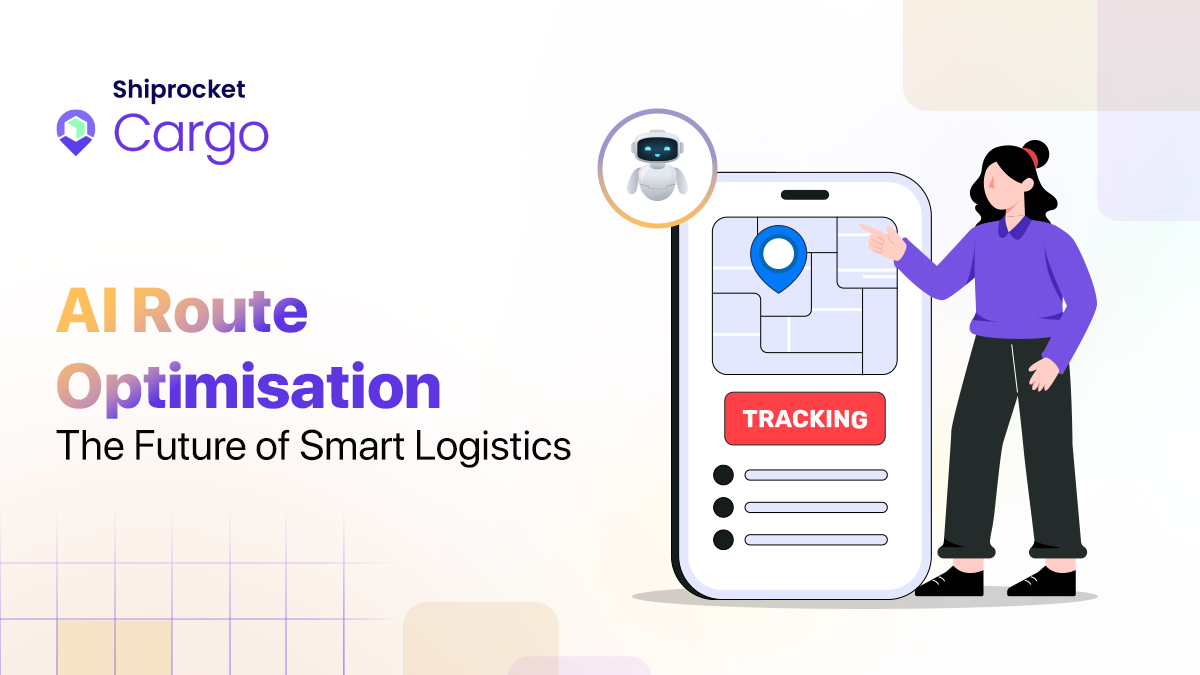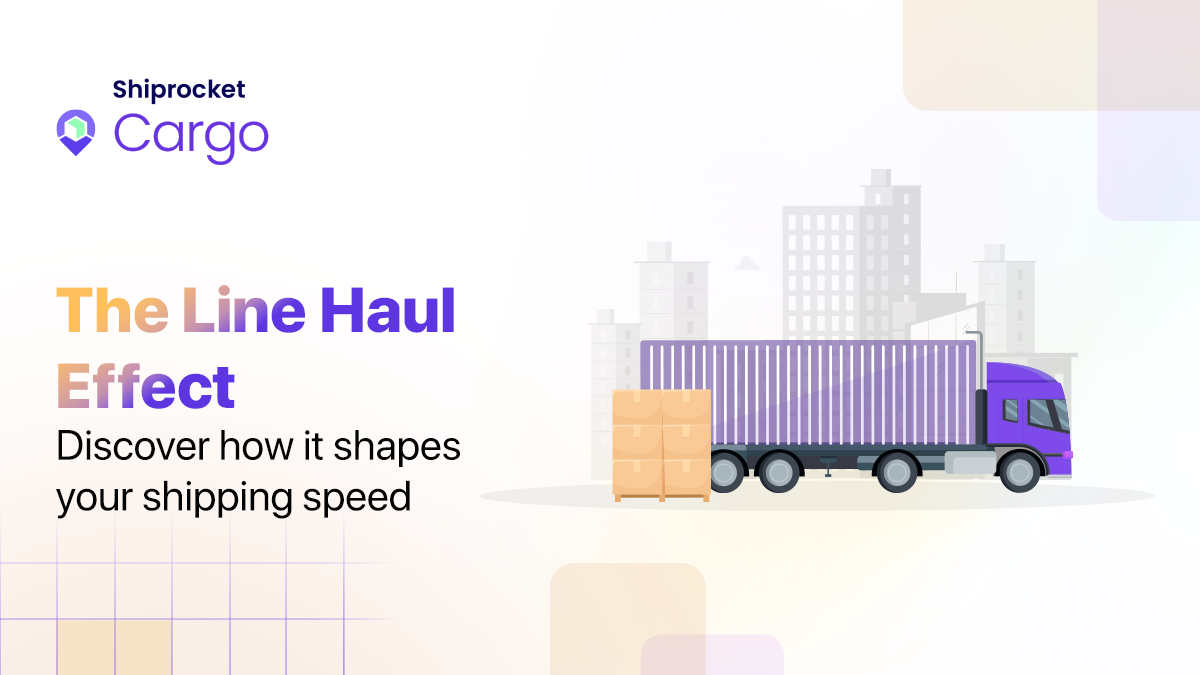What is Direct Store Delivery (DSD) and How Does It Work?
- How the Direct Store Delivery Model Works for Fast-Moving Goods?
- Centralised Distribution vs Direct Store Delivery Explained
- Why DSD Works for Beverages, Snacks, and Fresh Bakery Chains
- How DSD Enables Faster Replenishment and Better Shelf Management
- Risks and Complexities Involved in Direct Store Delivery
- How to Know If DSD Suits Your Product Category and Volume
- Role of eCommerce Fulfillment in Supporting DSD Operations
- How Shiprocket Cargo Helps Businesses Enable Direct Delivery at Scale
- Conclusion
Direct Store Delivery (DSD) is quickly becoming the preferred solution for fast-moving consumer goods, improving shelf availability, speeding up deliveries, and reducing stockouts. DSD bypasses centralised warehouses and ensures your products, especially perishables, get to store shelves faster, fresher, and more efficiently. In fact, DSD can boost shelf availability by up to 8%, directly improving in-store freshness and customer satisfaction.
DSD offers tailored inventory for each store, supports localised promotions, and cuts logistics costs by reducing warehousing. However, it’s not without challenges like operational complexity, scalability for smaller retailers, and more. To meet modern retail standards, you’ll need to understand how DSD works and plan your actions thoughtfully and thoroughly.
This blog will explore DSD in detail, covering how it works, why it’s ideal for perishables, risks and challenges involved, and more.
How the Direct Store Delivery Model Works for Fast-Moving Goods?
Direct Store Delivery (DSD) is a supply chain model where manufacturers or suppliers deliver goods directly to retail outlets, bypassing traditional distribution centers or warehouses. The DSD model is commonly used in the fast-moving consumer goods (FMCG) industry, particularly for products that sell quickly, are perishable or have a short shelf life, and are purchased frequently. This includes items like snacks, soft drinks and bottled beverages, bread and other baked goods, and milk, cheese, and other dairy products.
Here are the key steps involved in the DSD process:
- Order Placement: Retailers place orders directly with manufacturers or suppliers, usually via electronic systems, allowing real-time communication of demand and streamlining order processing.
- Product Picking and Packing: The supplier is responsible for selecting the correct products based on the retailer’s specifications and packing them securely before delivery directly to the store. Special care is taken for perishable or fragile products to maintain quality and minimise damage.
- Direct Delivery to Store: Products are loaded onto delivery vehicles (often company-owned) and transported straight to retail stores, bypassing any intermediate warehouse or distribution center.
- In-Store Merchandising (often in FMCG): Upon delivery, supplier representatives frequently assist with stocking shelves, managing product displays, and even organising promotional materials. It can help you increase product visibility and achieve optimal shelf conditions.
- Invoice and Payment Processing: The invoicing process is often handled electronically at the time of delivery, maintaining accurate records and reducing administrative overhead.
Now, let’s look at some reasons why DSD is used for fast-moving goods.
- Immediate Restocking: DSD enables manufacturers to rapidly replenish stock, minimising shelf gaps and quickly responding to spikes in consumer demand. It’s an important factor for perishable and high-turnover items.
- Enhanced Product Freshness & Quality: Direct shipments reduce the time products spend in transit or storage, ensuring maximum freshness and minimising spoilage, especially for items with a short shelf life like dairy, bread, and produce.
- Reduced Handling Risks: DSD reduces how many times a product is handled between the manufacturer and the store. Since there are fewer steps and less handling, there’s a lower chance that items will get damaged, lost, or mishandled. This is especially important for fragile products like glass bottles, perishables, or electronics.
- Operational Efficiency & Lower Costs: The DSD model reduces labour and storage costs for retailers by eliminating the intermediate warehousing stage and often delegating replenishment and merchandising to the supplier’s team.
- Improved Inventory Management: Real-time communication and direct delivery allow for more accurate inventory tracking, reducing the risk of overstocking or stockouts and offering greater responsiveness to market trends.
Common product categories that benefit from DSD:
| Product Category | Rationale for DSD |
| Snacks & Beverages | High turnover, need for freshness, frequent restocking |
| Dairy & Bakery | Perishable, require temperature control, short shelf life |
| Produce/Flowers | Extremely perishable, require gentle handling and rapid replenishment |
| Frozen Foods | Temperature controls, frequent store visits needed |
| Household Items | High-frequency purchase, frequent promotions |
Direct store delivery is the preferred model in distribution management for fast-moving and perishable goods because it ensures products reach the shelves faster, fresher, and more efficiently. It streamlines supply chains, reduces costs, enhances inventory turnover, and provides significant value to both retailers and manufacturers in the competitive FMCG sector.
Centralised Distribution vs Direct Store Delivery Explained
Centralised distribution and DSD are two core models for getting products from suppliers to retail shelves. They differ fundamentally in their delivery routing, inventory management, flexibility, and ideal product types.
| Feature | Centralised Distribution | Direct Store Delivery |
| Delivery Route | Supplier → Central Warehouse → Retail Store | Supplier → Retail Store |
| Product Types | Non-perishables, slow-moving, bulk goods | Perishables, fast-turnover, FMCG |
| Delivery Frequency | Less frequent, scheduled | More frequent, often daily or weekly |
| Flexibility | Less flexible, standardised deliveries | Highly flexible, customised by store |
| Product Freshness | Potentially lower (time in warehouse) | Higher (fast direct replenishment) |
| Inventory Management | Handled by the central warehouse | Managed by manufacturer/distributor |
| Economies of Scale | Strong, cost-effective for large volumes | Weaker, less bulk shipping with more stops |
| Supplier-Retailer Link | Less direct, mediated by the retailer’s distribution | Close relationships, direct communication |
| Costs | Lower transport but higher storage or handling | Higher transport, lower storage costs |
| Market Responsiveness | Slower adjustment to store demands | Faster response to fluctuations |
| Retail Space Use | Requires more on-site storage | Leaner, as shelves restocked more regularly |
Centralised distribution is usually favoured for items where cost and efficiency outweigh the need for flexibility or freshness. It excels in:
- Efficiency and cost control for non-perishables, due to consolidated bulk shipments and centralised inventory management.
- Simplicity for retailers, who own the supply chain from warehouse to store.
However, centralised distribution can struggle with spoilage or slow market reactions for fast-moving or perishable items, and relies on retailer competence for shelf stocking.
DSD benefits fast-moving, high-volume, or freshness-dependent goods. It is ideal when:
- Product freshness and quick market response are critical, such as with bakery, dairy, or other perishable items.
- Greater flexibility is needed for promotions, merchandising, or tailored deliveries.
- Retailer involvement in logistics is minimised, with the manufacturer/distributor handling restocking, displays, and shelf management.
DSD can be more complex and costly for manufacturers, and is less efficient for non-perishables or low-volume products.
Why DSD Works for Beverages, Snacks, and Fresh Bakery Chains
Key reasons why DSD is well-suited for these product categories include:
- Freshness Preservation: DSD helps keep products fresher by skipping warehouses and shipping items straight from the supplier to the retail store. This reduces handling and transit time, ensuring products like bread, pastries, beverages, and snacks arrive at stores at their peak freshness, preserving taste and quality essential for consumer satisfaction.
- Rapid Restocking and Turnover: Beverages, snacks, and bakery goods often have high demand and fast turnover. DSD allows suppliers to react quickly to changes in what customers are buying and deliver just the right amount of products to each store. Too much would lead to overstocking, and too little would cause stockouts.
- Adaptability to Seasonal and Market Trends: The flexibility of the DSD model allows suppliers to modify deliveries to meet seasonal peaks or promotional events (e.g., cold drinks in summer, holiday bakery specials), helping retailers stay aligned with customer preferences.
- Enhanced Inventory and Merchandising Control: Suppliers manage stocking and merchandising directly in stores, ensuring shelves are well-maintained and products are attractively displayed, which improves sales and reduces retailer labour.
- Cost and Operational Efficiency: By eliminating middlemen and warehouse storage, DSD reduces labour, warehousing, and distribution costs. This streamlined approach improves supply chain efficiency while also maintaining product quality.
How DSD Enables Faster Replenishment and Better Shelf Management
Here’s how DSD ensures faster replenishment and better shelf management:
- Quick Inventory Turnaround: DSD allows suppliers to restock stores multiple times a week or even daily, vastly reducing lead times compared to the traditional warehouse-based model. Bypassing distribution centers eliminates waiting periods typical of central warehousing. Products can move from supplier to shelf rapidly, ensuring timely replenishment, especially for fast-moving or perishable items like snacks, beverages, dairy, and produce.
- Improved Freshness and Reduced Stockouts: Because goods spend less time in transit and storage, perishable products reach shelves at peak freshness, enhancing shelf life and reducing the risk of stockouts. The frequency and speed of deliveries keep stock fresh and shelves consistently stocked, which is especially important in categories where product freshness directly impacts sales.
- Better Shelf Management: With DSD, manufacturers often take a hands-on role in merchandising. They are responsible for product placement, inventory rotation, and planogram compliance. Their direct involvement helps ensure products are displayed optimally and in stock, reducing the burden on store staff and allowing for tighter inventory control.
- Enhanced Operational Efficiency: DSD reduces warehouse handling costs, lowers store labour expenses, as manufacturers manage restocking for their lines, and allows for real-time adjustment of deliveries based on actual shelf needs.
- Greater Flexibility and Responsiveness: Suppliers can react almost instantly to changes in demand or promotions at the store level, making it possible to quickly replenish high-demand items and address local market needs.
Risks and Complexities Involved in Direct Store Delivery
Key challenges associated with DSD include:
- Increased Operational and Upfront Costs
DSD often requires a substantial investment in logistics infrastructure, such as vehicles, advanced route optimisation tools, and an expanded workforce to manage deliveries directly from manufacturer to store. Transportation costs can escalate rapidly, especially as prices for fuel and labour fluctuate.
- Inventory Management and Stocking Errors
Manufacturers and retailers must be adept at monitoring inventory across multiple stores in real time, risking overstocking (leading to increased storage costs) or understocking (resulting in lost sales). Mistakes in inventory stocking are costly, as correcting errors, such as delivering the wrong SKUs, entails high return, replacement, and opportunity costs.
- Complex and Demanding Logistics
DSD adds a layer of complexity due to the need for precise coordination between manufacturers, delivery drivers, and multiple store managers. This can lead to scheduling conflicts, invoicing errors, and communication challenges.
- Fulfillment and Scalability Challenges
Fulfilling both retail and direct-to-consumer (D2C) orders from stores requires careful planning to avoid selling inventory that isn’t physically present. Managing such fulfillment logistically is more complicated and expensive than centralised distribution.
- Increased Administrative and Documentation Burden
Without intermediaries, tasks such as order management, real-time inventory tracking, and accurate invoice production fall solely on the manufacturer or retail partner, demanding robust technology and process integration to minimise errors.
- Limited Suitability for Smaller Businesses or Networks
DSD is less effective for small-scale businesses or those unable to attract suppliers for low-volume orders. It is generally less scalable for companies with vast or geographically dispersed retail networks due to the associated increase in costs and logistics complexity.
- Regulatory and External Risks
When you use DSD to deliver products directly to stores, issues like heavy traffic, local laws, and city-specific delivery rules can get in the way. These problems can slow down deliveries, increase fuel or labour costs, and lead to fines or penalties if rules aren’t followed.
How to Know If DSD Suits Your Product Category and Volume
To determine whether DSD suits your product category and volume, evaluate the following criteria:
Product Characteristics that Favour DSD
- Short Shelf Life: Products like bread, dairy, eggs, or produce are ideal for DSD because they need to reach shelves quickly to maximise freshness and minimise spoilage.
- Fragile or Easily Damaged Goods: Items such as chips or bakery goods that are lightweight, large, or fragile benefit from reduced handling and direct delivery.
- Products Requiring Special Handling: Oddly shaped, temperature-sensitive, or regulated products (e.g., ice cream, pharmaceuticals) are better suited for DSD because you retain control over logistics and compliance.
- High Variety, Low Value Items: Categories with many SKUs and low per-unit value may find DSD more efficient, especially when retailers find it uneconomical to manage diverse, low-value inventory.
- Products with Seasonal Peaks: When demand spikes for some products, DSD lets you respond rapidly and keep shelves stocked.
Product Volume Considerations
- High Demand or Fast Turnover: DSD works well for products that move quickly and require frequent replenishment.
- Store Network Size: The model is generally more cost-effective for suppliers servicing a large number of retail outlets with consistent and significant volume per route.
Situational and Strategic Factors
- Regulatory Mandates: Some products may require DSD by law for safety and quality reasons, making it the only viable model for those items.
- Brand Control: DSD allows for direct influence over in-store merchandising, pricing, and promotions, supporting speciality or premium brands that need retailer support.
- Retailer Capabilities: If your retail partners lack appropriate storage or handling capacity, DSD provides essential oversight.
To decide whether DSD is the right fit for your business, there are some questions you need to ask:
- Is my product perishable, fragile, or regulated?
- Does fast shelf replenishment directly impact my sales?
- Can my business handle the logistical demands of frequent direct deliveries?
- Is the volume of sales per store high enough to justify direct delivery?
- Would DSD provide strategic advantages in display or relationships with retailers?
If most answers are yes, DSD is likely a fit.
Role of eCommerce Fulfillment in Supporting DSD Operations
Here are some ways eCommerce fulfillment supports DSD:
- Inventory Distribution & Localisation
eCommerce fulfillment often relies on a decentralised approach, with inventory spread across multiple fulfillment centers closer to target markets. This mirrors the DSD model, which involves delivering products directly to individual stores from these local hubs, rather than through a centralised warehouse.
- Order Processing & Speed
Fulfillment centers equipped with advanced technology manage real-time inventory, automate picking/packing, and optimise routing for fast and accurate order processing. This efficiency is essential for DSD, where rapid, store-specific deliveries support in-store product availability and freshness.
- Omnichannel Synergy
As omnichannel retail grows, retailers must ensure product availability both online and offline. Fulfillment centers support DSD by servicing not only direct-to-consumer orders but also replenishing store shelves, enabling buy-online-pickup-in-store (BOPIS), ship-from-store, and direct store restocking.
- Cost and Logistics Optimisation
By leveraging fulfillment centers in strategic locations, both eCommerce and DSD operations reduce logistics costs and shipping times. It means the same inventory can be used to serve multiple sales channels, minimising excess stock and transportation expenses.
- Customer Satisfaction
Fast, reliable replenishment of store shelves and efficient order fulfillment directly impact both end customer and retailer satisfaction. Prompt restocking helps stores avoid stockouts, while consumers benefit from fresher products and better availability.
How Shiprocket Cargo Helps Businesses Enable Direct Delivery at Scale
Shiprocket Cargo is designed to help businesses scale their direct delivery requirements with speed and efficiency. As a tech-driven logistics platform tailored for B2B cargo shipping, you can move heavy and bulk shipments seamlessly across India. Whether you’re shipping PTL, FTL, or air cargo, Shiprocket Cargo streamlines operations, reduces costs, and enhances customer satisfaction with every mile covered. By combining AI-powered courier selection, deep carrier networks, and robust ERP integrations, you get a solution built to handle scale, without compromising speed or service quality.
Key benefits of using Shiprocket Cargo for direct delivery at scale:
- Nationwide Reach: Deliver directly to over 24,000+ pin codes across India, with no middle layers.
- Smart Courier Selection: Use AI tools to pick the most efficient and cost-effective logistics partner every time.
- Cost-effective Scaling: Cut logistics expenses by up to 40% while maintaining reliability.
- Real-time Visibility: Get end-to-end tracking, from shipment creation to final delivery.
- Flexible Load Options: Choose from PTL, FTL, or air cargo, based on urgency and shipment size.
- Time-bound & Off-hour Deliveries: Meet SLAs even during non-standard delivery windows (11 PM–8 AM).
- Seamless ERP Integrations: Sync effortlessly with SAP, Navision, Unicommerce, and more.
- Instant Communication: Keep your customers informed through automated email/SMS updates.
- Quick Commerce Support: Schedule appointment-based deliveries for FMCG, pharma, or retail sectors.
Conclusion
Direct Store Delivery is more than a logistics shortcut, it’s a way to keep products fresher, shelves fuller, and customers more satisfied. By reducing touchpoints and moving goods straight from supplier to store, DSD helps businesses respond faster to demand while cutting down on inefficiencies.
Of course, making DSD work at scale requires the right logistics backbone. That’s where Shiprocket Cargo comes in. With our nationwide network, flexible load options (PTL, FTL, air), and seamless ERP integrations, we make it easier for businesses to deliver directly, reliably, and at lower cost.
Whether you’re in FMCG, retail, or perishables, our tech-driven platform helps you overcome the usual hurdles of speed, cost, and visibility, so you can focus on growing your business while we handle the heavy lifting.
Shiprocket Cargo: making Direct Store Delivery faster, smarter, and easier for Indian businesses.



